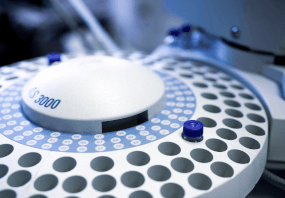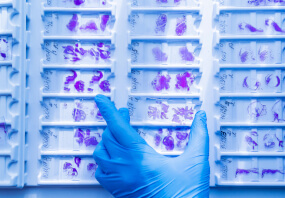General description
A cell-permeable rhodacyanine derivative that stabilizes Hsp70 (heat-shock protein 70) in its ADP-bound, substrate-binding conformation via reversible binding to Hsp70 nucleotide-binding domain (KD = 4.9 µM using YM-1-biotin) in a manner similar to the physiological Hsp70 co-chaperone Hip and YM-1 is shown to compete against Hip for Hsp70 binding. Both Hip overexpression and YM-1 treatment are shown to enhance cellular nNOS ubiquitination (2.57-fold of DMSO control monoUb nNOS level; 1 µM for 24 h) in nNOS-expressing HEK293 cells and promote proteasomal clearance of AR (androgen receptor) ligand-induced accumulation of unfolded AR112Q aggregates (by 35% with 1 µM YM-1 treatment for 72 h post 4 h 10 nM R1881 induction) in polyQ AR-expressing PC12 cultures. Likewise, YM-1, when co-supplemented with AR ligand dihydrotestosterone in food (1 mM each), reduces DHT-induced toxicity in transgenic Drosophila expressing human polyQ AR AR52Q as assessed by the severeness of rough eye phenotype and pupal eclosion rate. Also reported to downregulate Akt1/2 level in MCF7 cancer cells in a dose-dependent manner (by 53% with 6 h 10 µM treatment) and sensitize 4-OHT- (Cat. No. 479002) resistant TR-MCF7 to proliferation inhibition by 4-OHT in MTT assays (by 55%; 4 h 10 µM YM-1 alone prior to 44 h 10 µM 4-OHT treatment alone).
A stable and soluble MKT-077 analog that acts an allosteric activator of heat-shock protein 70 (HSP70). Its action appears to be similar to HSP70 interacting protein (HIP). Shown to convert HSP70 to its tight-affinity conformation and promote the accumulation of the ADP-bound form of HSP70. Increases the binding of HSP70 to its unfolded substrates . Also shown to enhance ubiquitination and degradation of nNOS and polyglutamine androgen receptor (polyQ AR) (at ~1 mM). Displays selective cytotoxicity across multiple cancer cell lines without affecting the normal cells. Also reported to restore tamoxifen sensitivity to a refractory tamoxifen-resistant MCF7 cells (~10 mM).
Please note that the molecular weight for this compound is batch-specific due to variable water content. Please refer to the vial label or the certificate of analysis for the batch-specific molecular weight. The molecular weight provided represents the baseline molecular weight without water.
Biochem/physiol Actions
Cell permeable: yes
Primary Target
HSP70
Reversible: yes
Packaging
Packaged under inert gas
Warning
Toxicity: Standard Handling (A)
Reconstitution
Following reconstitution, aliquot and freeze (-20°C). Stock solutions are stable for up to 3 months at -20°C.
Other Notes
Abisambra, J. et al. 2013. Biol. Psychiatry74, 367.
Miyata, Y., et al. 2013. ACS Chem. Neurosci.4, 930.
Wang, A.M., et al. 2013. Nat. Chem. Biol.9, 112.
Koren, J. 3rd, et al. 2012. PLoS. One.7, e35566.
Rousaki, A., et al. 2011. J. Mol. Biol.411, 614.
Legal Information
CALBIOCHEM is a registered trademark of Merck KGaA, Darmstadt, Germany
Molecular Weight: 381.51 (free base basis). Empirical Formula: C20H19N3OS2 · xHCl. Assay: ≥. 98% (HPLC). Quality Level: 100. form: solid. manufacturer/tradename: Calbiochem®. . storage condition: OK to freeze, protect from light. color: orange-red. solubility: DMSO: 10 . mg/mL. storage temp.: −. 20°C. Storage Class Code: 11 - Combustible Solids. WGK: WGK 3. Flash Point(F): Not applicable. Flash Point(C): Not applicable.- UPC:
- 51183308
- Condition:
- New
- Availability:
- 3-5 Days
- Weight:
- 1.00 Ounces
- HazmatClass:
- No
- MPN:
- 5006150001












